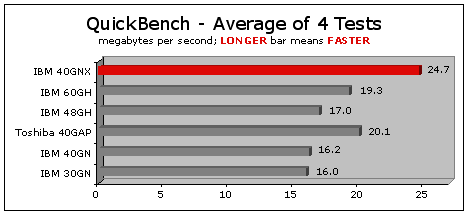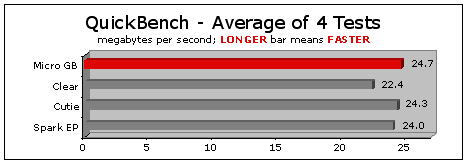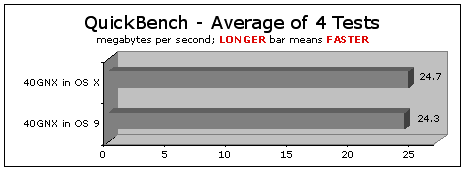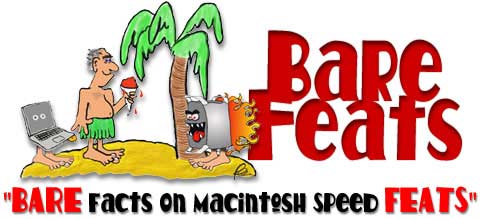|
I don't know
about you but I've been waiting with "baited
breath" for either the Toshiba Toshiba
4019GAX
drive (5400rpm, 16MB buffer, 9.5mm thin) or the
IBM Travelstar
40GNX
(5400rpm, 8MB buffer, 9.5mm thin). This week,
Trans
International
informed me that they had the 40GNX in stock. And
here's the results....
I put SIX
different 2.5 inch drives in the Wiebetech Micro GB
Portable FireWire drive. The first graph shows an
average of four tests: 10MB sustained read and
write, 1MB random read and write.

Next, I took the
fastest drive (the 40GNX) and put it in FOUR
different portable FireWire cases: Wiebetech
Micro GB, Trans
International
Clear 911, and FWDepot
Cutie, and FirewireDirect
Spark EP.

All the tests
above were run under OS 9 so I could take advantage
of the driver tuning provided by Intech's
Hard Disk Speedtools 3.5. But I wanted to know how
well the 40GNX performed when running under OS X.
The graph below shows the performance of the drive
inside the FWDepot.com Cutie:

CONCLUSIONS?
1. The new
Travelstar 40GNX rocks! It's 18% faster than the
nearest competitor. It's 49% faster than the 30GN.
At only 9.5mm thick, it will fit in the thin cases
like the FWDepot Cutie, the FirewireDirect Spark
EP, and the Smart Disk FireLite. It will also fit
in any model of PowerBook and iBook. And looking at
the specs, it should generate less heat and use
less power than previous 5400rpm drives like the
60GH and 48GH.
2. In previous
reports, some portable FireWire significantly
outperformed others, even though they had the same
essential chip set and firmware. But my tests were
faulty since they each had a different brand/model
of drive. This time, I put the same drive in three
different portable case kits. The performance
difference was no longer significant. That tells me
that the drive choice is critical, if speed is your
thing.
3. I did most of
my testing in OS 9 because the third party FireWire
drivers (like Intech's Hard Disk SpeedTools)
optimize performance by tuning the transfer block
size, etc. But I was curious if I would lose speed
when switching to OS X. I didn't see any speed loss
this time like I did with the 3.5 inch FireWire
drives.
WHAT DO
YOU BUY?
Well, the IBM
Travelstar 40GNX
is a no brainer. Better go visit Trans
International's
web site before they run out. I'm getting one for
my TiBook!
As for which
portable FireWire case you choose, it's a matter of
what features you prize, because performance is not
a factor when each uses the same drive.
What I like about
the FWDepot.com
Cutie is that fact that it is the lightest,
thinnest, smallest of any 2.5 inch case. And you
can get it in combo form with both FireWire and USB
2.0 ports.
I like the rugged
machined aluminum case of the Wiebetech
Micro GB. It also comes with FireWire and USB 2.0
ports. It takes both thicknesses of drives: 9.5mm
and 12.5mm.
The clear plastic
case used by Trans
International
for their portable drives is cool because you can
see all the components. It can handle both 9.5mm
and 12.5mm drives. It's also one of the easiest to
assemble and disassemble. That's important for me
since I'm always trying different drives and/or
upgrading. The same FireWire case kit is used by
other companies such as the Other
World Computing (Mercury
On-The-Go).
The
FirewireDirect
Spark EP is the "second smallest" portable FireWire
drive (see specs in table below). It's unique in
that it uses a small Li-Ion battery to provide
power to the drive when the bus power is not
transmitted through FireWire. For example, when you
use CardBus FireWire with your Lombard or
Wallstreet, there is no bus power transmitted to
the portable drive. So you need an A/C adapter.
With the Spark EP, you don't.
USB 2.0 VERSUS
FIREWIRE
In earlier
testing, I found the 480 megabit theoretical speed
of USB 2.0 (versus 400 megabit for FireWire) to be
only theoretical. In the real world, it is about
half as fast as FireWire. And, if you don't have a
USB 2.0 controller and run OS X, it becomes a very,
very slow USB 1.1 device. Ditto if you have any
slow USB devices on the chain.
There are rumors
that Apple will start including USB 2.0 in the next
revision of the Power Mac. Hopefully their
implementation of the interface will utilize more
of the theoretical bandwidth. (I used an Orange
Micro USB 2.0 PCI card in my testing that produced
disappointing performance.)
TEST
NOTES
The test
"mule" was an Apple
Titanium G4 PowerBook (800MHz)
When running
OS 9.2.2, the disk cache set to 512K (to
diminish effect of system caching), AppleTalk
OFF, Virtual Memory OFF, and Extensions set to
minimal (BASE).
Intech's Hard
Disk Speedtools 3.5 includes QuickBench and
QuickBench X, a great benchmark for testing
drives in both random and sequential mode. In
the charts above, I averaged four key tests:
10MB sustained read and write, 1MB random read
and write.
SPECIFICATION
OF FIREWIRE CASES (smallest specs in
bold)
|
|
Wiebetech
MicroGB
|
FirewireDirect
Spark EP
|
FWDepot
Cutie
|
TransIntl
Clear 911
|
|
Weight
with 40GNX drive
|
9.25
oz
(262 grams)
|
7.25
oz
(207 grams)
|
6.75
oz
(189 grams)
|
9.25
oz
(262 grams)
|
|
Thickness
|
.86
inch
(22 mm)
|
.75
inch
(19 mm)
|
.63
inch*
(16 mm)
|
1.1
inch
(27 mm)
|
|
Length
|
5.6
inches
(143 mm)
|
5.5
inches
(140
mm)
|
5.0
inches
(127 mm)
|
5.5
inches
(140 mm)
|
|
Width
|
3.0
inches
(75 mm)
|
3.2
inches
(81 mm)
|
3.0
inches
(75 mm)
|
3.5
inches
(89 mm)
|
SPECS
ON 2.5 INCH HARD DRIVES
- IBM
Travelstar 40GNX
40GB 5400rpm 9.5mm 8MB buffer
- Toshiba
40GB MK4018GAP
40GB 4200rpm 9.5mm
- IBM
Travelstar 60GH
60GB 5400rpm 12.5mm
- IBM
Travelstar 48GH
48GB 5400rpm 12.5mm
- IBM
Travelstar 40GN
40GB 4200rpm 9.5mm
- IBM
Travelstar 30GN
30GB 4200rpm 9.5mm
|





